Your Braces from Start to Finish
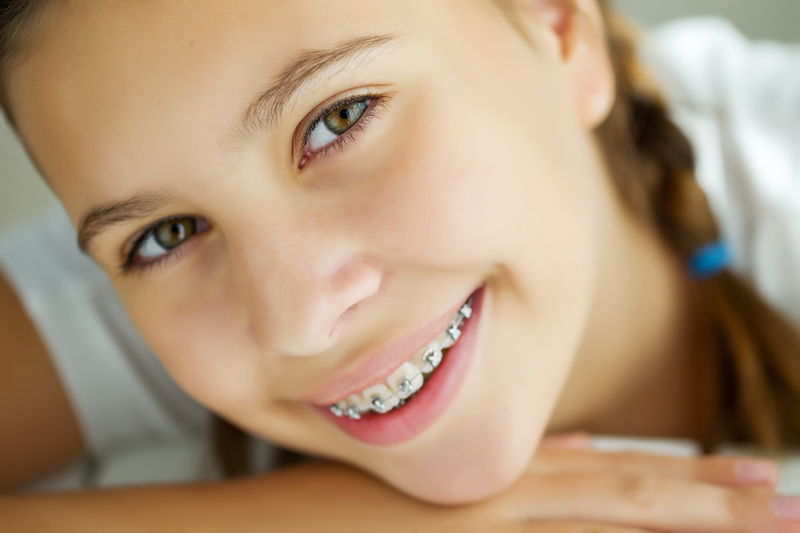
There are many things to think about when deciding to receive your braces. What type of braces should you choose? What age should you receive those braces? Then, after deciding what method of teeth straightening you want, you then have to learn how to properly care for your teeth. You will also have to get used to sometimes having sore teeth after your appointments and fitting in seeing the dentist. We can help you to know about your braces appliance from choosing a braces type, cleaning them, and avoiding tooth decay while you get a straighter smile.
Choosing Your Braces Style
Receiving braces is an exciting time for many people. It is the start of a better smile and a better you. But before you can get that straighter, more beautiful smile, you have to choose what style of braces you want. We offer:
- Traditional Metal Braces – These are the classic metal bracket and wire option that is most commonly chosen by patients. Patients who chose this option come in to have their wires tightened at each appointment.
- Ceramic Braces – These braces are a close cousin to metal braces. They have the same bracket and wire design of metal braces, except that they are made out of ceramic material. This helps decrease demineralization during your orthodontic treatment. Ceramic material is also naturally white, helping these braces to blend in with your teeth more than metal would.
- Lingual Braces – These are metal braces that are placed on the back of your teeth. Instead of just a square bracket, the metal must be custom-made to the shape of the back of your teeth. This is a discrete option that adults and teens love.
- Invisalign Treatment – This is the most invisible option available to our patients. Invisalign is a series of transparent aligners that you wear at night and throughout the day. You can remove them for eating, playing sports, cleaning your teeth and more.
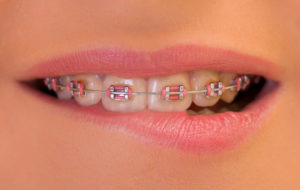
Getting Your Braces Put On
After you’ve chosen the style of braces you want, you need to have them fitted to your mouth. 3 out of the 4 options available to you will be bonded to your actual teeth. At our office, we make sure your teeth are thoroughly cleaned and dried before we bond brackets to them. With metal braces, we will use a cement bonding glue to adhere a metal bracket to the center of each of your teeth. Your back molars might receive a band that goes all the way around the tooth.
Once the metal bracket is cemented to the center of each tooth, we will pass a small metal archwire through each bracket both on top and on bottom. In the end, you will end up with a wire across the teeth on your upper jaw and across the teeth on your lower jaw. The glue we use may taste a bit unpleasant, but it is otherwise harmless. The entire process of getting your brackets and wires placed on your teeth will be between 1 and 2 hours.
The Process for Other Options
Depending on what option you have chosen, your braces process might be a bit different. Ceramic braces are applied the same way that metal braces would be, as they too consist of brackets and wires. However, if you choose to get lingual braces, we can’t simply place brackets on the backs of your teeth. Once Dr. Hardy has determined that you are an ideal candidate for lingual braces, he will take impressions of your teeth. He then sends them to a lab so that your brackets and wires can be custom made. The braces will then be bonded behind your teeth at a separate appointment.
For Invisalign treatment, we design a series of transparent aligners that you will switch out each week. We can take digital impressions of your mouth that we will use to design your aligners. We use a digital scanning system that sends images to a state-of-the-art printing machine. Then, each week you will have new aligners that you will simply replace. It’s that easy!
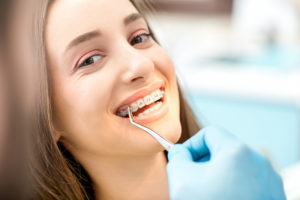
Your Orthodontic Experience
Most patients will have braces for 18-24 months. Some people don’t like braces, but the majority of people do. You can choose the style of your braces and if you want them to be hidden or noticeable. You can also dress up your braces with colorful bands if you so desire. Braces require more care than what you are used to. You must take more time with brushing and flossing, even using tools such as a waterpik, proxabrush and floss threaders to fully remove food from your braces. You must clean your teeth thoroughly to avoid tooth decay during your time with braces. We can show you how to do all of this at our office.
Each patient will come in every 4-6 weeks for orthodontic checkups. This is where we will examine your braces and how your teeth are moving. You will experience initial soreness and discomfort after you first get your braces. You might have this discomfort every time your braces get tightened as well. A simple over-the-counter pain reliever should help you as well as eating soft foods. Having braces changes life a little bit when it comes to cleaning your teeth (which takes longer), but the benefits far outweigh everything else. At the end of your treatment, you will have an amazing, beautiful smile that is sure to wow everyone around you. If you want to know more about your braces options, or want to get started on your journey today, call Belmar Orthodontics today at (303) 225-9016!
The Best Ages for Having Braces

If you have a desire to get braces, we commend you for choosing to have a better smile! Studies show that a better, straighter smile can increase your confidence, success and professional life. However, there are some key ages that having braces are the best for patients. If you have bite and alignment issues, it’s best to receive child orthodontics. For straightening, the teenage years are the best for wearing having braces. However, braces can benefit patients at any age and may even be needed more than once in life. Find out what orthodontic treatment can do for you at any age!
Child Orthodontics
The American Association of Orthodontics recommends that children have their first orthodontic visit between the ages of 7 and 8. Having and examination early as a child will detect bite and alignment issues that can become severe later on in life. This early visit is something that you definitely want your child to receive, as bite and alignment issues can lead to problems with speech. If the baby teeth are misaligned, then the adult, permanent teeth will come in misaligned as well. This will eventually lead to cracked, chipped or broken teeth when chewing and biting, as different teeth will take on different amounts of pressure.
There are several different types of bite problems children can have. One is crossbite, where one or more teeth are turned either in towards the tongue or out towards the cheek. Overbite is when the upper teeth overlap the lower teeth too much. Underbite is when the lower front teeth overlap the upper front teeth. In a healthy smile, the upper front teeth will rest on top of (and just a tiny bit forward) of the lower front teeth. If your child does have a bite or alignment problem, it’s easiest to fix while they are young, as the jaw is still growing and forming. Between 7 and 8 years old is the best time for having braces as a child to correct this problem.

Adult Orthodontics
Having braces as a teenager can vary depending on when all the permanent teeth come in. Once the permanent teeth have come in (somewhere around age 12), a child should be seen for a consultation. This is great time to straighten the teeth as the jaw is still growing. However, later in the teenage years and afterwards, the jaw will stop growing and straightening the teeth becomes harder. That is why the teenage years are the best to straighten a child’s teeth. Not only will having braces straighten crooked teeth, but they can also help your child have more confidence because they will produce a beautiful, straight smile after treatment. Straighter teeth are proven to boost confidence in children, teens and adults alike.
Adults benefit from receiving braces at any age. Even though the jaw has stopped forming, it’s never too late to get braces (except if you are in later years and losing your teeth). About 25% of people who have braces are adults. Getting a straighter teeth can boost your confidence and social life. Studies show that employers also hire someone with straight teeth over someone with crooked teeth. Other studies show that people find you more attractive, trustworthy, and datable if you have straight teeth.
Braces Options
Your options for braces will vary slightly depending on your age. In the past, traditional metal braces were your only option for straightening your teeth. This option is the one that has metal brackets attached to the center part of your teeth with a metal wire that goes through them on top and bottom. Metal braces aren’t your only option for treatment. For children, metal and ceramic braces are the best choices and the most economical. Ceramic braces mimic metal braces and have brackets and wires. However, instead of metal, these appliances are made from ceramic material, which matches the natural whiteness of your teeth. This is why they are sometimes known as “clear braces”.
For a more discreet look, lingual braces are also an option for adults. These are metal braces worn on the back of the teeth and custom-fitted to each tooth. However, the most discreet option for having braces is Invisalign. This is a series of transparent aligners that we custom-make for your mouth. You switch out the aligners every week and watch as your smile transforms. The best part about this option is that you can remove the aligners for eating, drinking, brushing your teeth, sports and more.

A Beautiful Smile at Any Age
No matter what option you choose, we know you will love the smile you’ll receive by having braces. Braces are not solely for children or teenagers, but also for adults. It doesn’t matter if you are 7 or 57; braces are great for patients at any age! Having braces will significantly reduce your risk for tooth decay and gum disease as well as broken, cracked or chipped teeth. They can get you ahead in life by helping you feel and appear more confident and successful. To answer the question about the best ages for braces, we say the best time is now! To learn more about what to expect with braces, call Belmar Orthodontics today at (303) 225-9016!
Know Your Orthodontic Options
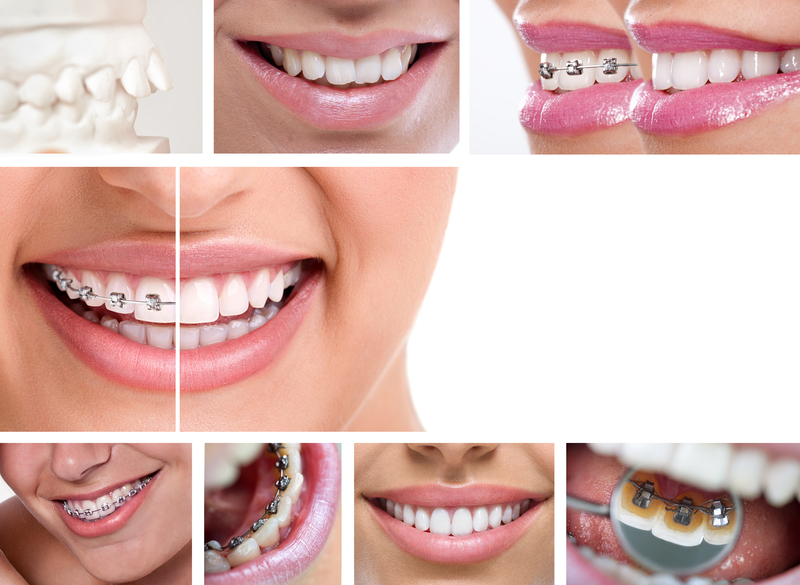
Orthodontic options for the world at large are diverse and exciting. Patients can choose from retainers to clear aligners to invisible, metal, ceramic and micro braces. Each orthodontic option has their advantages and disadvantages. Orthodontists have the specialized knowledge to council you on all your orthodontic options. Their recommendations are based on variables like your age, possible jaw imbalances, differences in the size of your teeth, your personal preferences and more. Orthodontists are trained to know what to use and when to use it, and will work with you to make the best decision.
How Orthodontics Can Benefit You
Many people know that it’s important to have a dentist. However, it’s also very important that you have an orthodontist as well. You can brush and floss your teeth several times a day, but still remain at risk for tooth decay. Teeth that are crooked are teeth that can trap food particles much easier than straight teeth. They are also harder to clean, meaning that that food can stay trapped and lead to tooth decay. If you invest in one of our many orthodontic options, we can straighten your teeth and reduce your risk for decay.
Straightening your teeth can also lead to higher self-esteem and confidence, as has been proven in many studies. Even children benefit from more confidence around peers and friends when they have straight teeth. At Belmar Orthodontics, we see children starting at age 7 and up through adulthood. We provide our patients many orthodontic options so that they can choose how they want to straighten their teeth and how they want to look while doing so. Our orthodontic options include traditional metal braces, ceramic braces, lingual braces and Invisalign treatment.

Traditional Metal Braces
When you think of braces, you probably think of traditional metal braces. These are our most popular orthodontic options available to patients, and the option chosen most often. These braces consist of a metal bracket that is attached to the center of each tooth that holds a metal archwire in place. Metal braces have proven themselves as one of the best ways to straighten your teeth, and are the most economic options our patients have. It is also the option used to correct bite and alignment problems, especially in children.
They are the same size and shape as metal braces and work the same way. However, ceramic braces are made out of ceramic material. Ceramic material is naturally white and will blend in with the color of your teeth. This makes them very hard to notice as compared to traditional metal braces. Another benefit of ceramic braces is that the ceramic material decreases your chances of demineralization, which can happen to some patients who wear metal braces.
Patients of all ages can wear metal braces. Kids love our ceramic clear braces and the ability to dress them up with colorful, bright bands of their choosing. Adults love them because they stay more hidden than traditional metal braces do. However, if you are looking for the sturdiness of brackets but don’t want them to be noticeable, consider investing your time in lingual braces.
Lingual Braces
You may know these braces by the names “nano braces” or “micro braces”. These are simply other names to describe these “incognito” braces. They are metal braces just like you would find traditionally worn by millions. However, the metal is permanently attached to the back of the teeth with dental cement along with the archwire. These braces are invisible when you smile, allowing you to share your beautiful smile with confidence during your treatment. They work similarly to Invisalign transparent aligners. However, you won’t have aligners that you are always removing.
Lingual braces are not right for every patient. Patients who have a deep vertical overbite won’t be able to fit these braces behind their teeth. Adults who have normal-sized teeth are the best candidates. It’s that teeth size that makes it one of our orthodontic options not available to children.
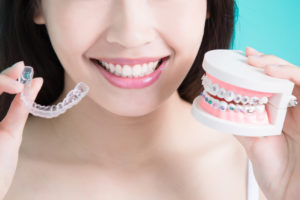
Invisalign
Many adults and teenagers are self-conscious about their appearance, especially when it comes to their smiles. Many view braces as something that children receive, not adults. However, you may be surprised to find that about 25% of people wearing braces are adults and only about 25% of braces wearers are actually children. That means that the majority of braces wearers are teens and adults. We know that adults need to look professional and exude confidence so that they can excel socially, professionally and emotionally. Luckily, we live in a day and age where you can straighten your teeth without others ever knowing.
One of the most inconspicuous ways you can straighten your teeth is through Invisalign treatment. This is a series of transparent aligners custom-made for you. You will switch out these aligners for new ones every 1-2 weeks so that your teeth slowly move into place. Invisalign treatment is the best out of all your orthodontic options that allows you the most freedom with your oral health. You can remove the aligners for eating, drinking, playing sports and for cleaning your teeth as you normally do. This option is not always available for children, but is available for teenagers and adults who are less likely to lose them.
Know Your Orthodontic Options
Orthodontics is a major investment in your oral health and in your life. Having a straighter smile can give you confidence and self esteem you didn’t previously have. Studies show that a better smile can help land you a job easier than those who have crooked teeth. As one of the most-noticed physical features you have, you want to invest your time in straightening your teeth. To find out more about our orthodontic options, call Belmar Orthodontics today at (303) 225-9016 and straighten your teeth today!
How Braces Design Has Evolved
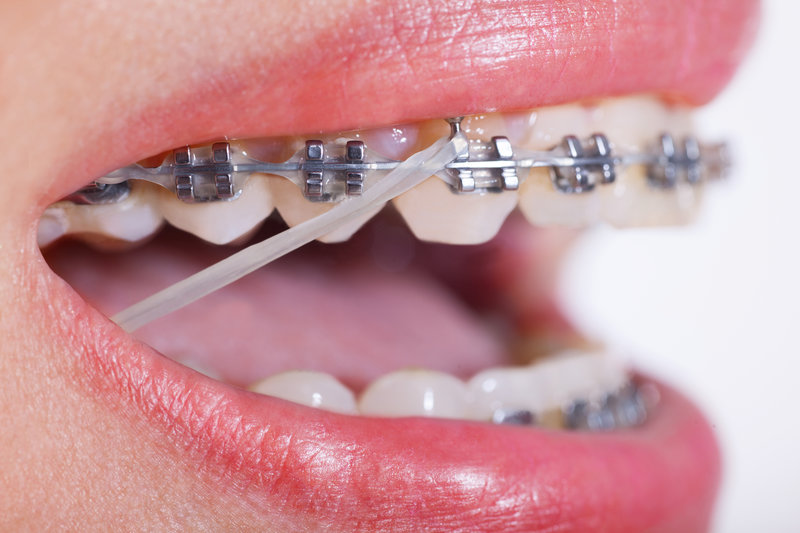
Did you know that orthodontic care dates back many centuries? The Ancient Egyptians, Romans and more all had methods for straightening the teeth. Some methods worked, while others were just downright painful. In modern times, braces design in orthodontia has been perfected. Each part of the braces is important and plays a role in straightening the teeth. Find out how braces came to be and why they are designed a specific way to get your teeth straight in as little time as possible!
Ancient Orthodontics
Braces design and orthodontic work itself has been around for many centuries; it’s not just something that we enjoy today! In fact, researchers have found that the Ancient Greeks, Etruscans, and the Romans were all some of the cultures that practiced orthodontia. However, their methods were vastly different than the methods used today. For example, in all of these cultures, braces design was different than the brackets and wires we know and love. The ancient Egyptians, however, did use metal bands around their teeth. These metal bands were found on mummified bodies, showing that even in death people valued the aesthetics of a straighter smile.
Ancient philosophers and physicians had to guess at how best to straighten the teeth. Some physicians forcefully pulled the teeth with crude tools until they were straight. In some of these cases, the resulting loose tooth had to be strapped to an adjacent tooth in order to heal into place. Methods such as these were just downright painful!
Evolving Braces Design
In later centuries, more and more philosophers and physicians experimented with better braces design. Europeans in the 17th and 18th centuries began using wax molds to make impressions of the teeth. Some also found plaster to be useful in making models of the teeth. Models allowed physicians to view the teeth in their crooked state and then plan how they wanted the teeth to eventually look. Pierre Fauchard is considered the “Father of Dentistry”. He created strips of metal that had spaced holes that fit around the teeth. This is a baseline design of the brackets and wires braces design that is used today to fix tooth alignment.
Even though Fauchard made some worthy orthodontic advancements, Edward Hartley Angle is actually the one considered to be the “Father of Modern Orthodontics.” He made a very effective braces design and also identified malocclusion (or misalignment) and how to correct it properly. Eventually in the 1970s, orthodontists were sticking to the braces design of attaching brackets to the teeth and fitting an archwire around both the upper and lower jaws.
Modern Orthodontics
In eras past, braces design was done according to the needs of adults. Children did not commonly receive orthodontic care, whereas in modern times they do. Early orthodontic care for children is needed to correct bite and alignment issues that can become severe later in adolescence and especially in adulthood. Once a child has this early orthodontic care, they will later receive braces once more to straighten the permanent teeth as they come in. Many people, therefore, have braces twice in their life if they choose to have orthodontic care. In modern times, around 4.5 million people each year wear braces.
Traditional metal braces are the most popular option available to patients, and are the most effective at straightening the teeth. However, technology also allows patients to choose lingual braces, ceramic braces and Invisalign transparent aligners. Lingual braces are metal and are attached to the inside of the teeth (tongue-side). Clear, ceramic braces are made from ceramic material and mimic the same design as traditional metal braces. However, they help decrease demineralization and their white material blends into the color white of the teeth. Invisalign is a system of transparent aligners that a patient can switch out every 1-2 weeks. The most aesthetically pleasing option, it also allows patients to remove the aligners for normal brushing, eating, cleaning, and more.
Parts of Braces
In order to take care of your braces well, it’s important to know about all the different parts and why they are important. We will use traditional metal braces as an example. The individual elements that work to correct your teeth are referred to as the “appliance.” The main parts of your metal braces will include:
- Bands – Patients will have a thin ring fitted to their back molars when receiving braces. This ring is typically made of stainless steel and is used to secure other orthodontic attachments, such as hooks, brackets, or tubes.
- Brackets – A bracket can either be bonded to the tooth using a tooth-colored cement or it can be attached to a band. They are usually made of stainless steel or clear ceramic depending on the type of braces design you choose. They guide and support the archwire into the appropriate placement.
- Archwire – This is held by brackets or other orthodontic attachments. The archwire is designed to guide the shifting of the teeth during treatment. These wires are traditionally made from stainless steel, but can also be made of titanium.
- Elastics (rubber bands) – These rubber bands help create a force to move the teeth in a particular direction. These are especially helpful for pulling down or pushing very crooked teeth into place. The elastics are often attached to a molar band and upper ball hook.
- Elastic Ties – Elastic ties are small rubber bands that go over the brackets. These hold the archwire in place. They are available in a variety of colors that patients can switch out every time they come in for a check-up.
- Springs – Using the force of a small spring, a space can be opened or closed between the teeth. These springs go between brackets and around the archwire. They are usually made out of stainless steel or titanium.
Get Fitted for Your Braces
Braces are an amazing way to straighten your smile. Braces design has been perfected to get your teeth straight in no time. To get fitted for your set of braces, call Belmar Orthodontics today at (303) 225-9016.
Before, After and During Braces
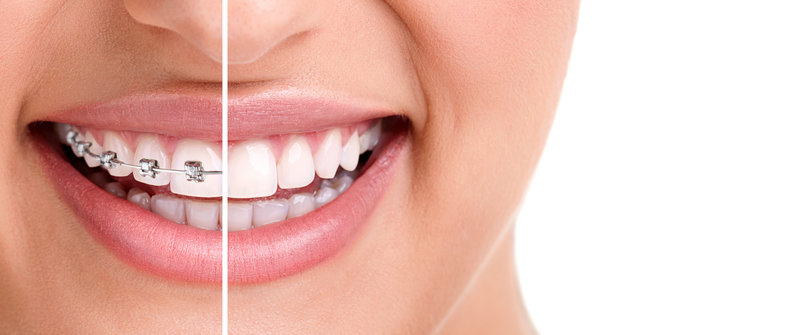
What do you need to know before, after and during braces? How do you prepare for orthodontic care? The American Dental Association says that patients can greatly benefit from both dental and orthodontic care if they want a better smile. Seeing a dentist often as a child can help you prepare for braces in the future. Seeing a dentist and orthodontist early on can also help prevent serious oral health issues. When preparing for braces, you will receive an oral exam, x-rays, and have molds of your teeth made. You may even need dental work done as well. We can help you know what you need to do before braces, during, and after braces to achieve a better smile!
Preparing for Braces
Seeing your dentist is the best way to prepare for braces. The ADA recommends that patients visit their dentist at least biannually (meaning twice a year). Patients who have gum disease or are prone to tooth decay (cavities) may need to visit their dentist more often than that to prevent problems. A dentist can detect abnormal bites or alignment in children. This early detection can help children to see an orthodontist early-on for care before bite and alignment problems become severe. Most patients see an orthodontist around the early adolescent years to straighten the teeth. This is because most alignment problems are apparent after the permanent teeth have come into the mouth.
Studies show that most patients who receive braces are between 8 and 14 years old. You will visit your dentist and then often see an orthodontist after. That orthodontist will do a full exam of your teeth including your jaws and mouth and how your bite and alignment are. X-rays help to determine the position of the teeth in the jaw and help an orthodontist plan how your teeth must move to come into correct alignment during your treatment. Much like a dental office, you will have molds (also called “impressions”) made for your teeth. A plaster model of your teeth will be made that the orthodontist can made a plan from. In preparing for braces, you should plan on between 18-24 months of wearing braces to receive a straight smile. However, know that braces can be fun and are an investment in your future.
Caring for Your Braces
Your braces will be a new experience for you. At first, you may have a tender mouth, as your teeth will have to get used to the new brackets that are on them. Brackets are the squares attached to each tooth. There will be an archwire that runs through each bracket and helps mold your jaw arch correctly. You may also have elastic rubber bands and steel bands in the back of your teeth that are attached to the tooth. You must take extra time each day to care for your braces properly. If you brushed for 2 minutes before braces, you will have to extend that time now. Each bracket can get food stuck in it with any given meal, so it’s important that you brush each tooth and especially brush the bracket at different angles to dislodge food that has become stuck.
Flossing is extra important as well, because it is usually a step that is skipped if patients are short on time. Flossing requires setting aside around 10 minutes of your time to do it right. Use a floss threader to thread the floss under your wire, then floss between your teeth like normal. You will have to thread the floss for each individual tooth, but the time is worth it as it helps to decrease your risk for tooth decay between the teeth. Some patients may need to use a proxy brush or toothpicks to dislodge foods from the brackets. A mouthrinse with fluoride can help keep the teeth healthy as well.
After Your Orthodontic Care
You’ve spent 18-24 months to get a better smile. Now what? It is highly important to wear your retainer every single day after your braces come off. Your teeth have been moved into place very recently and can even start changing back into their crooked paths in the first month after braces if the retainer is not worn. Wear your retainer according to what the orthodontist suggests. If you follow their recommendations for taking care of your smile, you can look forward to many decades of a better smile with beautiful teeth.
A smile is not complete once it is straight. You still must brush and floss the teeth every single day to prevent tooth decay and gum disease, both of which can destroy your smile. However, both of these are avoidable if you follow basic oral hygiene.
A Better Smile Today
If you care for your braces well, then you can expect to have a beautiful smile after your treatment is over. A better smile can bring you added confidence and success, which is what we want for every patient. If you are preparing for braces, follow our recommendations. You can even learn more about preparation, what to do with braces in special circumstances, and ask questions you may have after your care is over. Simply call our Belmar Orthodontics office at (303) 225-9016 to know more!
Receiving Dental Care with Braces
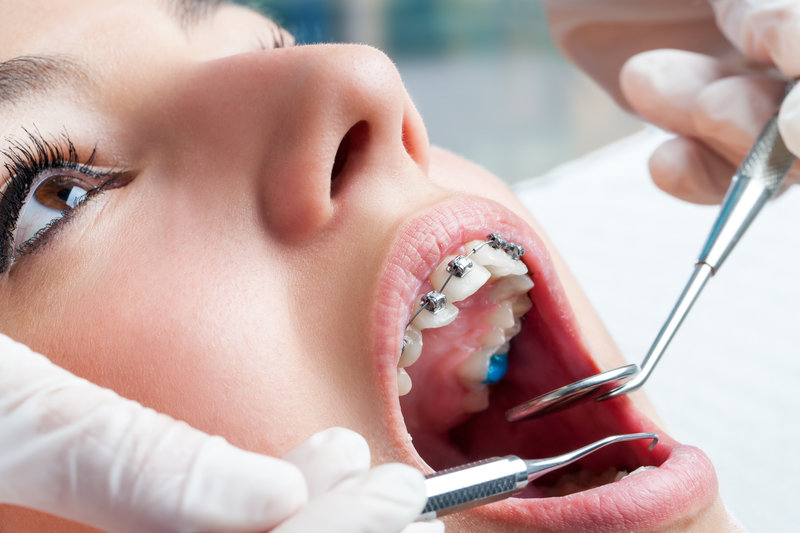
Dentist hands working on young teen patient with dental braces.
Should you receive dental care with braces or is seeing the orthodontist sufficient? Continue regular checkups with your dentist even if you are frequently seeing your orthodontist. Braces make you more prone to problems such as plaque buildup and tartar. Depending on the kind of braces you choose, your teeth may require additional steps to stay clean with braces than without. For some, the enamel can also weaken with braces. However, there are ways to keep your teeth healthy and clean while you have braces. Modern-day orthodontics offers treatment options everyone can be comfortable with and will still allow patients to receive proper dental care at the same time. We can answer frequently asked questions for receiving dental care with braces and help you with tips for taking care of your braces so your smile stays healthy.
Dentists and Orthodontists
Did you know that orthodontists attend dental school just like dentists do? Dentists and orthodontists are similar in their schooling up to a point. However, although both professions deal with the health of your teeth, they both do separate services. Dentists perform services such as:
- Comprehensive exams and diagnostic x-rays
- Dental cleanings
- Oral cancer screening
- Laser tissue treatment
- Periodontal treatment/Scaling and root planing
- Dental sealants
- Cavity fillings/Tooth colored fillings
- Sedation dentistry
- Porcelain veneers and crowns
- Cosmetic bonding
- Dental bridges and dental implants
- Root canal therapy
- Teeth whitening
An orthodontist performs other services different than a dentist, although they are skilled in dental practices. Orthodontists receive 4 years of undergraduate education, where they then attend dental school for 4 years. After dental school, they attend a postdoctoral program to learn orthodontia. A dentist fixes problems with your teeth in general, while an orthodontist fixes problems with teeth alignment as well as your bite and jaw alignment. Basically, every orthodontist is a dentist, but not every dentist is an orthodontist. Patients benefit from having both a dentist and an orthodontist to maintain a healthy mouth.
Caring for Your Teeth
Taking care of your teeth is a bit different with braces than it was without them. During your orthodontic treatment, it is particularly important to maintain good oral health through proper oral hygiene. Brackets and wires in your mouth make it much easier for food particles to get stuck. When those food particles are not removed, it leads to other dental issues like tooth decay (cavities) and gum disease. Your teeth may also demineralize or erode in the areas where your brackets were attacked to the teeth. Areas on the enamel surface lose minerals in this case, which is what causes white squares to form on the teeth. If you drink beverages that stain the teeth easily, you might be left with uneven stains once the brackets have been removed.
With braces, you should still follow the American Dental Association’s recommendation to brush the teeth at least twice a day. We recommend that you brush the teeth much more than that, as food particles can get stuck in the brackets at every single meal. Make sure to avoid hard foods like hard candies, chips, apples, nuts, popcorn and more with your brackets. Also avoid sticky foods such as gum, caramel, taffy, tootsie rolls, and gummies as these foods are much harder to get out of all the small areas of your braces. A lot of caring for your braces is watching what you eat and then cleaning the teeth often after you do eat.
Cleaning with Braces
Flossing is one of the daily tasks that will be more difficult with braces because there is an archwire that blocks the floss from going in and out of the spaces between the teeth with ease. The solution for this is to use threadable floss or a floss threader. With a floss threader, you use regular floss and thread it through the eye of the threader much like you would with a sewing needle and thread. You then floss the threader between each tooth individually. Floss that comes threadable will be harder at one end and will be able to be threaded between the teeth without having to have a separate threader.
After brushing with a toothbrush, you can also use a proxabrush, which looks like a small Christmas tree brush. You place this proxabrush between two brackets, below the archwire, and you brush up and down. This will get food that is hard-stuck in your brackets. Brushing after every meal will reduce how much food gets into your bracket and stays there.
Dental Care with Braces
Even though you are seeing an orthodontist frequently, you must continue to visit your dentist throughout your care! An orthodontist will get your teeth straight, but you receive dental cleanings, comprehensive exams, and cavity care from a dentist, not an orthodontist. Both professions deal with the teeth, but they both deal differently with the teeth. Only a dentist can find cavities and fill them for you. A dentist can provide all the services we listed above, which are all very important to keep the teeth healthy. Receiving frequent dental exams and cleanings are some of the best dental services you can receive while wearing braces, because keeping the teeth clean and free of cavities will help your smile be that much more beautiful in the end.
Schedule a Dental Visit
Your tooth enamel can suffer permanent damage if you don’t take extra care with your teeth with braces. That’s why it’s even more important to receive dental care while you have braces. Be vigilant with your oral hygiene every single day. Don’t skip days! You are spending months of your life to receive a straighter smile. You want that smile to also be a beautiful one at the end of your treatment. In the end, it is very important to receive dental care during braces and to take care of them yourself every day at home. If you have questions about caring for your braces, call our Belmar Orthodontics office today at (303) 225-9016.
Do You Need Braces?
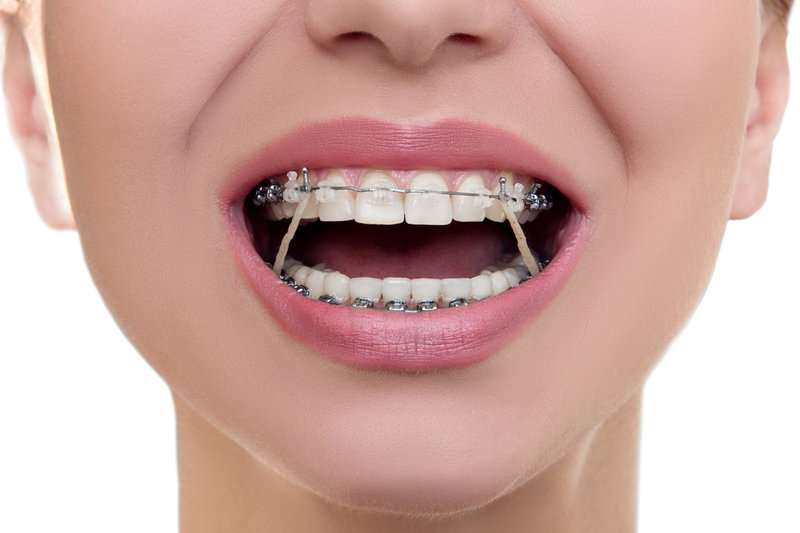
How do you know if you need braces? When you look in the mirror at your smile, do you like what you see? Are your teeth straight or crooked? Is your bite comfortable? Do any of your teeth collide when you bite, swallow or chew? Sometimes it is easy to spot signs that you may need braces, and at other times the signs might not be readily apparent. At Belmar Orthodontics, we work with you and your general dentist to determine the best course for your oral health needs and to determine if you need braces.
Deciding If You Need Braces
Braces is an investment: an investment in your money and an investment in your time. It’s always important to look at factors that determine whether you need braces or not, as you will have braces for about 18 months or so of your life. However, if you do make the choice to receive braces, you can be sure that you are making an incredible investment for your future and for your health. What are factors to consider when deciding if you need braces? Some factors include the status of your smile, your age, health reasons and bite and alignment problems.
Examining Your Smile
Do you love the smile you have? Is it a straight smile or is it crooked? Many patients seek orthodontic care because their smile is crooked or could use some improvement. Orthodontic care makes a huge difference when it comes to straightening your smile quickly and doing it correctly. Only an orthodontist has received the education needed to straighten your smile the best way possible. An orthodontist spends about 10-11 years in training and schooling to do orthodontics. That generally includes 4 years of undergraduate work, 4 years of dental school and an additional 2-3 years training in orthodontics. These professionals truly know what they are doing when they make a plan for your teeth.
If your smile is crooked, you are a great candidate for receiving braces, no matter if you are a child, teenager or an adult. Straightening your smile is one of the best ways to boost your confidence. In a study conducted by Invisalign, it was found almost 30% of people noticed a person’s smile during a first impression. Those with a straighter smile had a better chance at landing a job than someone with a crooked smile. They were also considered to have a better personality, be more attractive and were 58% more likely to be successful. Investing in a straighter smile can really help you go places in life!
Braces for Most Ages
You are never too old to receive braces. Children, teenagers and adults are all sporting various forms of braces all over the world. In fact, in just the United States alone, there are about 4.5 million braces wearers each year. About 1/4th of those are adults and a large portion are children as well. The braces you wear depend on your age. For children, most braces are for correcting bite and alignment problems. For adults and teenagers, the main goal is to straighten those pearly whites.
Your Options
Braces have come a long way in recent years. No longer are traditional metal braces your only option for receiving orthodontic care. You can choose:
- Traditional Metal Braces – These are the tried and true method for straightening the teeth. They are also the most economical choice and the top choice for teenagers. Dress these brackets up with colorful bands at every orthodontic appointment!
- Incognito Lingual Braces – Want the strength of metal braces without having a visible mouth full of metal? Lingual braces are custom-made metal braces for the inside of your teeth (the tongue-side). This hidden apparatus allows you to straighten your teeth in secret, making it a popular choice among adults.
- Clear Ceramic Braces – Ceramic braces are made from ceramic material and naturally are white just like the teeth. Even the archwires can be made white to blend into the teeth better. For braces that feel like metal braces but hide themselves a bit more, ceramic braces may be for you!
- Invisalign Transparent Aligners – This is an options that adults love! Many adults find metal braces to be childish or unattractive. However, Invisalign treatment has proven to be effective in straightening the teeth. This series of transparent aligners gently pushes the teeth into their proper place in about the same time as metal braces. The aligners can be removed for eating, drinking, sports and easy cleaning.
Bite & Alignment Issues
All of our orthodontic options are great for aligning your teeth. Children may need braces if bite and alignment problems are present, and this is actually the reason many children do have braces. During the childhood years, the mouth is still growing and the jaw is still forming. You never want to just let bite and alignment problems go unchecked, as they can create problems such as difficulty chewing, speaking, and talking as well as make the face grow differently and make the teeth harder to clean.
Children with bite misalignments need braces between ages 7-9 to correct problems before they become severe in adolescence and adulthood. This will save a lot of time, pain and procedures later on in life.
Getting Your Braces
There are many reasons that you may need braces. Straightening the teeth makes them easier to clean and can reduce your risk for tooth decay and gum disease. Orthodontic treatment can improve your appearance, boost your confidence and correct problems with your bite that can become severe later on in life. If you need braces, don’t hesitate to schedule your appointment! Call our Belmar Orthodontics office today at (303) 225-9016.
What Will Wearing Braces Be Like?
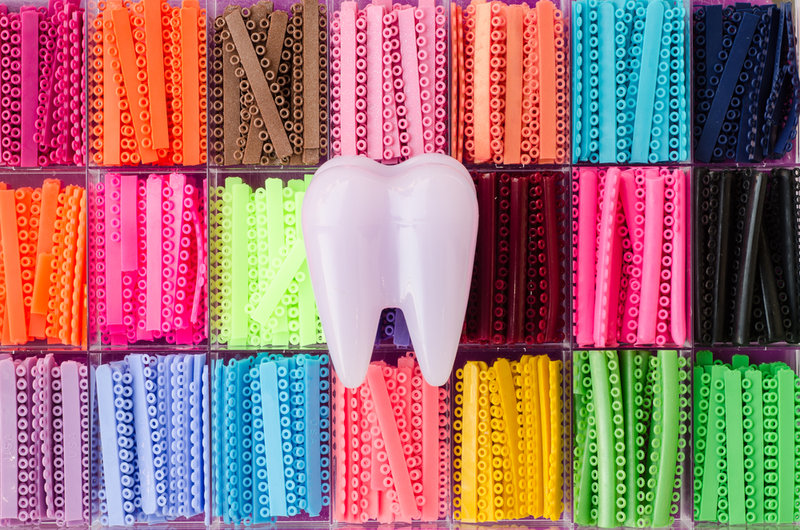
Whether you are currently wearing braces or looking into getting some, knowing what your life with braces will look (and feel) like can help you prepare for success and choose the right form of treatment for your needs and lifestyle. Belmar Orthodontics can help educate you on what to expect wearing braces and what you can do now to achieve the best outcome.
Braces: What Are They?
Braces have been around for many centuries. Researchers have found that orthodontic appliances actually date back as early as 1000 B.C. Even then people were anxious to straighten out their smiles. Braces are appliances that exert a certain amount of force on the teeth in order to align the top and bottom sets of teeth as well as the upper and lower jaw. The goal is to have a straight smile with teeth that are set in a beautiful arch around the mouth and jaws that line up with the teeth coming together evenly.
Components of Braces
Braces consist of brackets, wires and bands. On the teeth, they look like metal squares on each tooth with metal wires going through those metal squares. The squares are the brackets and they are cemented to the center of each tooth with a special bonding agent. The bracket is designed so that it can support a wire (called an archwire) that will go through it. Think of all these brackets as tiny workers who are holding up a strong wire.
There are two archwires: one that goes along the top teeth and one that goes along the bottom teeth. These archwires help shape the arch of the teeth in the mouth so that they make a perfect arch and so the upper and lower teeth line up with one another. Traditional metal braces also have rubber bands that go around each individual bracket. These are to help the gums from catching on the metal bracket hooks and also provide a patient the ability to add a pop of color to their mouth. Bands come in all different shades and can be customized to what you like.
Types of Braces
There are many options when it comes to wearing braces. Your option will largely determine how your braces look and how they feel. We provide the following options to our patients:
- Traditional Metal Braces – This is the option we explained above, and the most popular option among patients. This is also the most economical choice when it comes to price.
- Incognito Lingual Braces – This is an option similar to traditional metal braces and are popular with professionals and adults. The brackets are bonded to the back of the teeth and provide a hidden straightening apparatus to patients. Patients will adjust to these braces much the same as traditional metal braces, only they’ll feel the brackets on the tongue-side of their teeth instead of the cheek side.
- Clear Ceramic Braces – Much like metal braces, this system uses brackets to align the teeth. However, the brackets are made from ceramic and their white material blends in with the teeth. Even the wires can be made white. These will act and feel the same as metal braces, only with better blending with the teeth and greater stain-fighting power.
- Invisalign – This is a system of progressive, custom-fit aligners that gently move the teeth into their ideal position. The clear, removable design of these aligners renders this orthodontic treatment virtually invisible to others. It will feel like you are wearing a snug retainer or covering for the teeth and needs to be worn throughout the day. This treatment method allows patients to drink, eat and clean the teeth normally and with ease.
What To Expect Wearing Braces
There is some discomfort and adjustment when first wearing braces. Because the brackets are bonded to the teeth and there are archwires adjusting the position of the teeth, you may be sore for a few days. It’s best to eat soft foods the first few days as your teeth adjust to their appliances. A simple over-the-counter painkiller can help with discomfort. Although many patients feel mild discomfort when first wearing braces, some patients don’t.
It will take a few days to get used to the brackets and wires. You will be able to feel them during the day as they sit against your cheeks. However, you will get used to them in about 1-3 days to the point where you won’t even notice your braces. They will soon become a part of you and cleaning them as well as going to orthodontic appointments will become routine. As with any new thing, there is always an adjustment period. With braces, that adjustment period is short.
You’re Not Alone
When it comes to wearing braces, you’re definitely not alone. There are over 4.5 million people any given year that are wearing braces. Many of those are teenagers, but a large portion are also children and adults. In fact, at least ¼ of all braces wearers (or 25%) are adults. Each year more and more teenagers and adults are receiving braces.
In the past, there used to be many stigmas about braces, such as them being unattractive. Studies show, however, that braces have become quite the luxury and are seen as such. The New York Times, for example, did an article about braces and just how important they are to people. Many families literally go without needs and many wants to receive orthodontic care, even if money is really tight. Braces are a luxury that many children, teens, and adults alike are eager to have. Just think: when wearing braces, you are wearing a luxury item.
Your Braces
Remember, braces are something to have fun with! If you have traditional metal braces or ceramic braces, you can dress up your braces with colorful bands that make you stand out. Or you can choose an option that is discreet. Overall, no matter what option you choose, wearing braces for a time will help keep your mouth healthier and your smile straighter. A better smile leads to more confidence. Who wouldn’t want that? If you’re ready to receive a great set of braces, call our Belmar Orthodontics office today at (303) 225-9016!
How Do Adult and Child Orthodontics Differ?

Advancements in adult and child orthodontics have triggered a rise in adults seeking treatment for oral challenges they have had for years. When deciding to pursue orthodontic treatment, understanding the differences between adult and child orthodontics can help you decide what type of treatment is right for you. Everyone should want their best smile. Feeling confident about your teeth and smile is essential for healthy self-esteem and confidence. You can achieve both of those benefits with braces.
Benefits of Braces
For years, braces have helped millions of people receive a more beautiful smile. About 4 million Americans on average each year are wearing braces. You may think that braces are mostly for teenagers, but you may be surprised to know that about 25% of braces wearers are actually adults. A large portion of those 4 million are also children. Braces benefit people of all ages and it’s never too late to get your own set. Why are braces so important? Straighter teeth keep the mouth in proper alignment and help even out the pressure placed on the jaw each time you talk, bite, eat and more. When the teeth are straighter, they are easier to clean, especially to floss in between the teeth. This is why people with straighter teeth have a reduced risk for oral health problems such as tooth decay and gum disease.
Tooth Decay and Gum Disease
The biggest oral health problems are tooth decay and gum disease. These problems come from lack of good oral hygiene habits. If you skip on brushing and flossing the teeth (or not doing them enough) you may start to have problems. When food sits on the teeth, the sugars from the food you ate (or drank) mix with bacteria in the mouth. This mixture creates a sticky acidic substance called plaque. That plaque works hard to erode your tooth enamel. If it sits on the teeth long enough without being cleaned through brushing or flossing, it will seep into the center of your tooth, called the pulp. This is where that acidic plaque will start to decay your tooth. If left untreated, the problem can become severe. Tooth decay is the most wide-spread childhood disease.
Gum disease is similar to tooth decay, but it has to do with the gums. Plaque is not your friend in this case either. When it sits on the teeth for too long, it can irritate the gums. You may notice your gums begin to turn more red and they may become inflamed. Over time, if good oral hygiene habits are not established, the gums will begin to recede from the teeth. This can eventually cause the teeth to begin falling out. About 64.7 million American adults suffer from some form of gum disease. That’s not even including the number for children! Even though tooth decay and gum disease are so wide-spread, they can both be prevented by brushing and flossing several times a day and by establishing and keeping good oral hygiene habits.
Child Orthodontics
One area we specialize in is child orthodontics. A large portion of the people that wear braces are children. The American Association of Orthodontics recommends that children have their first orthodontic visit between ages 7 and 8. Having an examination early-on helps prevent the progression of orthodontic issues that may be present. In children, we can detect certain orthodontic problems—such as underbite or crossbite—that are present. These problems can be fixed with child orthodontics and other bite and alignment problems such as overbite, openbite and malocclusion. The jaw is still forming in children, so performing child orthodontics at this age can help easily correct problems that are harder to deal with as an adult. Even if your child does not show any signs or symptoms of orthodontic complications, you can still benefit from child orthodontics. Some benefits include:
- Monitoring the facial and jaw development
- Observing the progress of incoming teeth
- Guiding incoming teeth into their proper positions
- Reducing the risk of impacted teeth
- Decreasing the risk for permanent tooth extractions
- Detecting hidden dental issues
Adult Orthodontics
Adult and child orthodontics are very similar. However, it often takes longer to correct bite and alignment problems in adults than it does children or teenagers. This is because the jaw and mouth has stopped growing by adulthood. If bite or alignment problems are severe, an adult may have to look into receiving surgery to correct the problem. Adults also have a few more options when it comes to what kind of braces they would like. Adults and teenagers have the option to choose these types of braces besides traditional metal braces:
- Lingual Braces – These are also known as “Incognito” braces. They are a hidden braces apparatus on the tongue-side of your teeth. Worn on the inside, no one will even know you are wearing braces.
- Invisalign Transparent Aligners – This is a series of removable transparent aligners that are custom-made for your teeth. They can be removed for activities such as eating, drinking, sports and more. Because they are transparent, they are also a secret way for adults and teenagers to discreetly straighten their teeth.
- Clear Ceramic Braces – Made of ceramic material, these braces fit in with the color of your natural teeth. Ceramic material helps reduce the risk for demineralization and staining.
Your New Smile
Whether you are an adult or child, it’s never too late to improve your smile! For people of all ages, a straight smile boosts confidence and self esteem. For adults, that new smile of yours could help you land a job. Studies have also shown that straighter smiles make you appear more confident, successful, attractive and even more trustworthy to others. The benefits of braces are just too good to pass up! If you would like a new smile today, call our Belmar Orthodontics office at (303) 225-9016!
Incognito Lingual Braces Vs. Traditional Metal Braces
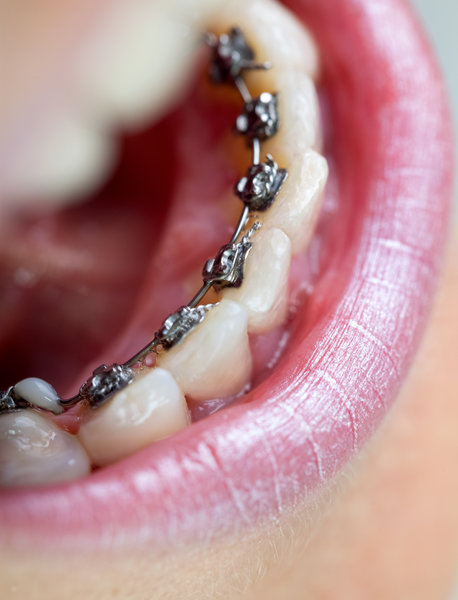
Young woman with lingual braces
There are many services we offer when it comes to straightening the teeth, including Incognito lingual braces and traditional metal braces. These two options are very similar, however, lingual braces are made slightly different than traditional metal braces because of where and how they are worn. Both will give you amazing straightening results and both are services we provide. What choice is right for you? Which is best for your budget and for your time? We can help you know the difference between Incognito lingual braces and traditional metal brackets and help you choose which option you’ll love the most. As always, with professional orthodontic care through Belmar Orthodontics, you can be sure you receive quality straightening power no matter what option you choose.
Investing In Braces
When you invest your time in braces, you are making an investment for the rest of your life. Your smile is one of the first physical features others see. Is that smile making an impression? We want all of our patients to have beautiful, healthy smiles. Why? Beautiful smiles are quite attractive to others. In studies, those with a straighter, more beautiful smile are seen as more attractive, trustworthy, confident and successful. Straighter smiles tell others that you take care of yourself.
When it comes to your health, a straighter smile can also help reduce your risk for tooth decay and gum disease. This is because the teeth are aligned and much easier to clean, especially in between the teeth. Plaque has a harder time staying stuck on the teeth and causing problems when the teeth are easier to clean. So when it comes to both aesthetic and health reasons, braces can really change your life! There are many options when it comes to choosing the right braces for you. Some of the most popular options in orthodontics are traditional metal braces and Incognito lingual braces.
Traditional Metal Braces
These are the braces you probably imagine when you think of braces. They are traditional because they’ve been around for decades and are proven to straighten your teeth effectively. Traditional metal braces are worn on the front of the teeth. In times past, the term “metal mouth” was a term some used to describe those who had these braces. However, studies have shown that braces have become a luxury in modern times.
Traditional metal braces are more popular than ever, especially among teenagers. Metal braces have also taken on a much smaller and sleeker design so you no longer have a mouth so full of metal. The best part about traditional metal braces (besides how well they work) is that they are also the least expensive option when it comes to orthodontic care. You can also dress up these braces with bright bands of color and express yourself the way you want.
Incognito Lingual Braces
Love the idea of metal braces but don’t exactly love how noticeable they are? We are excited to be able to offer our patients an alternative to traditional metal braces: hidden lingual braces. There are about 4.5 million Americans that currently wear braces. Of those, 25% are adults. The majority of the rest of braces wearers are teenagers. It is common for some adults and teenagers to avoid orthodontic treatment because they find metal braces to be unattractive or distracting. However, most people love to have straighter teeth. The solution? Incognito lingual braces!
With lingual braces, you can achieve the same results as traditional braces with a hidden treatment apparatus on the tongue-side of your teeth (by the tongue and palate). This is why they are referred to as “incognito” braces—they stay hidden (or incognito) as you straighten. We will take an impression of your teeth and make customized brackets fit perfectly to you. Lingual braces work much like traditional metal braces by slowly shifting the teeth into proper alignment. Unlike metal braces, each tooth must have its own installment of brackets and wires, as the lingual braces are shaped to each tooth back. Special training and technical expertise are needed to install these braces, and they do cost a bit more than traditional metal braces. However, you receive the trade-off of these braces being so undetectable.
Other Braces
There are more options than just traditional metal braces and Incognito lingual braces. We also offer:
- Invisalign – For those seeking an option that goes beyond Incognito braces, they can invest in Invisalign. This is a series of transparent aligners that are replaced every 1-2 weeks. They are virtually invisible and can be removed for eating, drinking, cleaning and sports.
- Ceramic Braces – Made from ceramic material, these white braces seek to have the functionality of traditional metal braces while blending into the teeth. Both the brackets and the wires can be made white so the braces are hard to see against the teeth.
Getting Your Braces
When it comes to receiving your braces, we want to give you options so that you truly enjoy your braces experience. Both traditional metal braces and lingual braces will work hard to straighten your smile. The dentists at Belmar Orthodontics have the expertise, training and experience to install both traditional metal braces or Incognito lingual braces to your smile. To start your orthodontic treatment with metal or lingual braces today, call our Belmar Orthodontics office today at (303) 225-9016!

